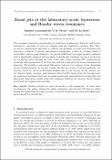Files in this item
Zonal jets at the laboratory scale : hysteresis and Rossby waves resonance
Item metadata
| dc.contributor.author | Lemasquerier, Daphné | |
| dc.contributor.author | Favier, B. | |
| dc.contributor.author | Le Bars, M. | |
| dc.date.accessioned | 2022-10-24T11:30:08Z | |
| dc.date.available | 2022-10-24T11:30:08Z | |
| dc.date.issued | 2021-03-10 | |
| dc.identifier | 281184147 | |
| dc.identifier | 3e610dfa-9f9a-4fc7-9ae1-b6646eb4ff02 | |
| dc.identifier | 85099288041 | |
| dc.identifier.citation | Lemasquerier , D , Favier , B & Le Bars , M 2021 , ' Zonal jets at the laboratory scale : hysteresis and Rossby waves resonance ' , Journal of Fluid Mechanics , vol. 910 , A18 . https://doi.org/10.48550/arXiv.2008.10304 , https://doi.org/10.1017/jfm.2020.1000 | en |
| dc.identifier.issn | 0022-1120 | |
| dc.identifier.other | ORCID: /0000-0002-9795-6214/work/119212654 | |
| dc.identifier.uri | https://hdl.handle.net/10023/26233 | |
| dc.description | The authors acknowledge funding by the European Research Council under the European Union's Horizon 2020 research and innovation program through grant number 681835-FLUDYCO-ERC-2015-CoG. | en |
| dc.description.abstract | The dynamics, structure and stability of zonal jets in planetary flows are still poorly understood, especially in terms of coupling with the small-scale turbulent flow. Here, we use an experimental approach to address the questions of zonal jets formation and long-term evolution. A strong and uniform topographic β -effect is obtained inside a water-filled rotating tank thanks to the paraboloidal fluid free upper surface combined with a specifically designed bottom plate. A small-scale turbulent forcing is performed by circulating water through the base of the tank. Time-resolving particle image velocimetry measurements reveal the self-organization of the flow into multiple zonal jets with a strong instantaneous signature. We identify a subcritical bifurcation between two regimes of jets depending on the forcing intensity. In the first regime, the jets are steady, weak in amplitude, and directly forced by the local Reynolds stresses due to our forcing. In the second one, we observe highly energetic and dynamic jets of width larger than the forcing scale. An analytical modelling based on the quasi-geostrophic approximation reveals that this subcritical bifurcation results from the resonance between the directly forced Rossby waves and the background zonal flow. | |
| dc.format.extent | 43 | |
| dc.format.extent | 15432418 | |
| dc.language.iso | eng | |
| dc.relation.ispartof | Journal of Fluid Mechanics | en |
| dc.subject | Bifurcation | en |
| dc.subject | Quasi-geostrophic flows | en |
| dc.subject | Waves in rotating fluids | en |
| dc.subject | QC Physics | en |
| dc.subject | Atmospheric Science | en |
| dc.subject | Mechanical Engineering | en |
| dc.subject | NDAS | en |
| dc.subject | AC | en |
| dc.subject.lcc | QC | en |
| dc.title | Zonal jets at the laboratory scale : hysteresis and Rossby waves resonance | en |
| dc.type | Journal article | en |
| dc.contributor.institution | University of St Andrews. Applied Mathematics | en |
| dc.identifier.doi | https://doi.org/10.48550/arXiv.2008.10304 | |
| dc.description.status | Peer reviewed | en |
| dc.date.embargoedUntil | 2021-07-11 |
This item appears in the following Collection(s)
Items in the St Andrews Research Repository are protected by copyright, with all rights reserved, unless otherwise indicated.

